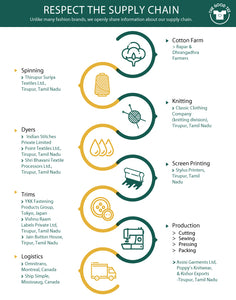Elevate Your Wardrobe, Elevate Your Health: The Relationship Between Quality Fabrics and Well-Being

In our fast-paced world, where trends come and go, it's easy to overlook the importance of the fabrics we wear. However, the quality of the materials against our skin can have a profound impact on our overall well-being. From physical comfort to emotional satisfaction, the fabrics we choose can play a significant role in enhancing our health. In this comprehensive guide, we'll explore the intricate relationship between quality fabrics and well-being, uncovering the science behind their benefits and offering insights into how you can elevate your wardrobe to promote better health.
Understanding the Importance of Quality Fabrics
Quality fabrics go beyond mere aesthetics; they offer tangible benefits that contribute to our health and well-being. The quality of materials and processes used to create fabrics can affect our skin, hormones, body temperature, and overall comfort. We'll explore how the fabrics we choose can elevate our wardrobe and enhance our health. Additionally, we'll discuss the potential risks associated with cheap materials and the environmental benefits of opting for sustainable clothing options. By being more conscious of the fabrics we choose, we can make informed decisions that prioritize both our health and the well-being of the planet.
The Science of Fabric and Skin Health
Our skin is the body's largest organ, and the fabrics we wear can have a significant impact on its health. Low-quality materials, such as synthetic fabrics or rough textures, can cause friction against the skin, leading to irritation, chafing, and even rashes. Additionally, these fabrics may contain harmful chemicals and dyes that can disrupt our hormones and overall health. Synthetic materials like polyester, nylon, and acrylic are often treated with chemicals such as formaldehyde, phthalates, and flame retardants during manufacturing, which can be absorbed by the skin and cause adverse reactions.
By contrast, natural fibers like cotton, silk, and linen are less likely to contain these harmful substances, making them a safer and more skin-friendly choice. Opting for clothing made from organic and/or sustainably sourced materials, like the organic cotton used at The Good Tee, can further reduce your exposure to unnecessary chemicals and promote better skin health in the long run.
The Physical and Emotional Comfort of Quality Fabrics
Beyond their physical benefits, quality fabrics also contribute to our emotional well-being. The tactile experience of wearing soft, luxurious materials can evoke feelings of comfort, security, and pleasure. When we feel good in our clothes, we exude confidence and positivity, which can have a ripple effect on our overall mood and mental health. Investing in well-made garments that make us look and feel our best can boost our self-esteem and enhance our sense of well-being.
Choosing Quality Fabrics for a Healthier Lifestyle
When building a wardrobe that promotes well-being, it's essential to prioritize quality over quantity. Opt for natural fibers like organic cotton, linen, bamboo, or wool, which are breathable, eco-friendly, and gentle on the skin. Look for garments with seamless construction and soft finishes to minimize friction and irritation. Additionally, consider the source and production process of your clothing to ensure ethical and sustainable practices. By selecting garments made with care and craftsmanship, you can create a wardrobe that not only looks good but also supports your health and values.
It's essential to extend our consideration of fabric beyond clothing and into items we use every day such as towels and sheets. Just as the fabrics we wear impact our skin health and overall comfort, the materials we use for bedding can significantly influence our sleep quality and well-being. Polyester sheets, for example, may be less breathable and more prone to trapping heat and moisture, leading to discomfort and disrupted sleep. Opting for natural fibers like cotton or linen for towels and sheets can enhance breathability, absorbency, and overall comfort, promoting better sleep and skin health. We can create environments that support our health and vitality by carefully selecting fabrics for all aspects of our lives.
Avoiding Cheap Materials and Supporting Sustainability
Avoiding cheap materials that may be filled with toxins, chemicals, and plastic is crucial. Synthetic fabrics can not only irritate the skin but also have long-term health implications. Investing in high-quality, natural fabrics can reduce exposure to harmful substances and promote better health.
Moreover, choosing more sustainable clothing options can have significant environmental benefits. Natural fibers are biodegradable and renewable, making them a more eco-friendly choice compared to synthetic materials. By supporting brands that prioritize sustainability and ethical production practices, you can reduce your carbon footprint and contribute to a healthier planet for future generations. The Good Tee is committed to ethical manufacturing processes and supports farmers and clothing makers involved in the entire process with complete transparency.
How The Good Tee Values Wellbeing
The Good Tee values the importance of quality fabrics in supporting wellbeing. They use certified organic/fairtrade cotton, eco-friendly dyes, and sustainable and ethical production processes to ensure that the clothing produced not only supports the health of the consumer but also the people in India who make these garments. The company is committed to doing good for the people making the clothes, the people wearing the clothes, and the environment. The high standards set by The Good Tee in terms of social responsibility and environmental sustainability should serve as an inspiration for other companies.

Frequently Asked Questions
1. Why are natural fibers preferred for clothing?
Natural fibers like cotton, silk, and linen are preferred for clothing because they are breathable, hypoallergenic, and gentle on the skin. They allow for proper airflow and moisture absorption, keeping the body cool and comfortable. Additionally, natural fibers are biodegradable and environmentally friendly, making them a sustainable choice for clothing production.
2. How can I tell if a fabric is high quality?
High-quality fabrics are characterized by their softness, durability, and attention to detail. They feel luxurious against the skin and maintain their shape and color after repeated wear and washing. Look for garments with smooth seams, even stitching, and a tight weave or knit. Natural fibers are often a sign of quality, as they tend to be more breathable and long-lasting than synthetic materials.
3. Are there any health benefits to wearing high-quality fabrics?
Yes, there are several health benefits to wearing high-quality fabrics. These include reduced risk of skin irritation, allergic reactions, and discomfort. Quality fabrics are gentle on the skin, allowing for proper airflow and moisture regulation. They also promote better posture and physical comfort, which can contribute to overall well-being.
4. How can I care for high-quality fabrics to maintain their longevity?
To maintain the longevity of high-quality fabrics, it's essential to follow care instructions carefully. Always read the garment's care label and wash it according to the recommended instructions, using a gentle, non-toxic detergent and cold water if possible. Avoid using harsh chemicals or bleach, as these can weaken the fibers and cause damage. Additionally, store garments properly, away from direct sunlight and moisture, to prevent fading and mildew. Regularly inspect and mend any loose threads or seams to keep your clothing in top condition.







Leave a comment